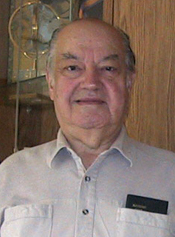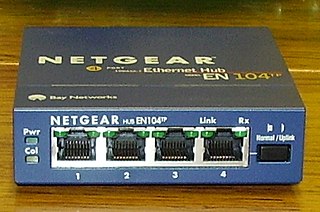Related Research Articles

Asynchronous Transfer Mode (ATM) is a telecommunications standard defined by the American National Standards Institute and ITU-T for digital transmission of multiple types of traffic. ATM was developed to meet the needs of the Broadband Integrated Services Digital Network as defined in the late 1980s, and designed to integrate telecommunication networks. It can handle both traditional high-throughput data traffic and real-time, low-latency content such as telephony (voice) and video. ATM provides functionality that uses features of circuit switching and packet switching networks by using asynchronous time-division multiplexing. ATM was seen in the 1990s as a competitor to Ethernet and networks carrying IP traffic as, unlike Ethernet, it was faster and designed with quality-of-service in mind, but it fell out of favor once Ethernet reached speeds of 1 gigabits per second.

Ethernet is a family of wired computer networking technologies commonly used in local area networks (LAN), metropolitan area networks (MAN) and wide area networks (WAN). It was commercially introduced in 1980 and first standardized in 1983 as IEEE 802.3. Ethernet has since been refined to support higher bit rates, a greater number of nodes, and longer link distances, but retains much backward compatibility. Over time, Ethernet has largely replaced competing wired LAN technologies such as Token Ring, FDDI and ARCNET.
Multiprotocol Label Switching (MPLS) is a routing technique in telecommunications networks that directs data from one node to the next based on labels rather than network addresses. Whereas network addresses identify endpoints, the labels identify established paths between endpoints. MPLS can encapsulate packets of various network protocols, hence the multiprotocol component of the name. MPLS supports a range of access technologies, including T1/E1, ATM, Frame Relay, and DSL.

A wide area network (WAN) is a telecommunications network that extends over a large geographic area. Wide area networks are often established with leased telecommunication circuits.
In computer networking, cell relay refers to a method of statistically multiplexing small fixed-length packets, called "cells", to transport data between computers or kinds of network equipment. It is a reliable, connection-oriented packet switched data communications protocol.
Circuit switching is a method of implementing a telecommunications network in which two network nodes establish a dedicated communications channel (circuit) through the network before the nodes may communicate. The circuit guarantees the full bandwidth of the channel and remains connected for the duration of the communication session. The circuit functions as if the nodes were physically connected as with an electrical circuit.
In telecommunication and computer engineering, the queuing delay or queueing delay is the time a job waits in a queue until it can be executed. It is a key component of network delay. In a switched network, queuing delay is the time between the completion of signaling by the call originator and the arrival of a ringing signal at the call receiver. Queuing delay may be caused by delays at the originating switch, intermediate switches, or the call receiver servicing switch. In a data network, queuing delay is the sum of the delays between the request for service and the establishment of a circuit to the called data terminal equipment (DTE). In a packet-switched network, queuing delay is the sum of the delays encountered by a packet between the time of insertion into the network and the time of delivery to the address.
A virtual circuit (VC) is a means of transporting data over a data network, based on packet switching and in which a connection is first established across the network between two endpoints. The network, rather than having a fixed data rate reservation per connection as in circuit switching, takes advantage of the statistical multiplexing on its transmission links, an intrinsic feature of packet switching.
In telecommunications, packet switching is a method of grouping data into short messages in fixed format, i.e. packets, that are transmitted over a digital network. Packets are made of a header and a payload. Data in the header is used by networking hardware to direct the packet to its destination, where the payload is extracted and used by an operating system, application software, or higher layer protocols. Packet switching is the primary basis for data communications in computer networks worldwide.
In telecommunications and computer networking, a network packet is a formatted unit of data carried by a packet-switched network. A packet consists of control information and user data; the latter is also known as the payload. Control information provides data for delivering the payload. Typically, control information is found in packet headers and trailers.
A multilayer switch (MLS) is a computer networking device that switches on OSI layer 2 like an ordinary network switch and provides extra functions on higher OSI layers. The MLS was invented by engineers at Digital Equipment Corporation.
In communications, Circuit Switched Data (CSD) is the original form of data transmission developed for the time-division multiple access (TDMA)-based mobile phone systems like Global System for Mobile Communications (GSM). After 2010 many telecommunication carriers dropped support for CSD, and CSD has been superseded by GPRS and EDGE (E-GPRS).

Paul Baran was an American-Jewish engineer who was a pioneer in the development of computer networks. He was one of the two independent inventors of packet switching, which is today the dominant basis for data communications in computer networks worldwide, and went on to start several companies and develop other technologies that are an essential part of modern digital communication.

A network processor is an integrated circuit which has a feature set specifically targeted at the networking application domain.

An Ethernet hub, active hub, network hub, repeater hub, multiport repeater, or simply hub is a network hardware device for connecting multiple Ethernet devices together and making them act as a single network segment. It has multiple input/output (I/O) ports, in which a signal introduced at the input of any port appears at the output of every port except the original incoming. A hub works at the physical layer. A repeater hub also participates in collision detection, forwarding a jam signal to all ports if it detects a collision. In addition to standard 8P8C ("RJ45") ports, some hubs may also come with a BNC or an Attachment Unit Interface (AUI) connector to allow connection to legacy 10BASE2 or 10BASE5 network segments.
In telecommunications and computer networking, connection-oriented communication is a communication protocol where a communication session or a semi-permanent connection is established before any useful data can be transferred. The established connection ensures that data is delivered in the correct order to the upper communication layer. The alternative is called connectionless communication, such as the datagram mode communication used by Internet Protocol (IP) and User Datagram Protocol (UDP), where data may be delivered out of order, since different network packets are routed independently and may be delivered over different paths.
A forwarding information base (FIB), also known as a forwarding table or MAC table, is most commonly used in network bridging, routing, and similar functions to find the proper output network interface controller to which the input interface should forward a packet. It is a dynamic table that maps MAC addresses to ports. It is the essential mechanism that separates network switches from Ethernet hubs. Content-addressable memory (CAM) is typically used to efficiently implement the FIB, thus it is sometimes called a CAM table.

In routing, the data plane, sometimes called the forwarding plane or user plane, defines the part of the router architecture that decides what to do with packets arriving on an inbound interface. Most commonly, it refers to a table in which the router looks up the destination address of the incoming packet and retrieves the information necessary to determine the path from the receiving element, through the internal forwarding fabric of the router, and to the proper outgoing interface(s).

A network scheduler, also called packet scheduler, queueing discipline (qdisc) or queueing algorithm, is an arbiter on a node in a packet switching communication network. It manages the sequence of network packets in the transmit and receive queues of the protocol stack and network interface controller. There are several network schedulers available for the different operating systems, that implement many of the existing network scheduling algorithms.

SoftEther VPN is free open-source, cross-platform, multi-protocol VPN client and VPN server software, developed as part of Daiyuu Nobori's master's thesis research at the University of Tsukuba. VPN protocols such as SSL VPN, L2TP/IPsec, OpenVPN, and Microsoft Secure Socket Tunneling Protocol are provided in a single VPN server. It was released using the GPLv2 license on January 4, 2014. The license was switched to Apache License 2.0 on January 21, 2019.
References
 This article incorporates public domain material from Federal Standard 1037C. General Services Administration. Archived from the original on 2022-01-22.
This article incorporates public domain material from Federal Standard 1037C. General Services Administration. Archived from the original on 2022-01-22.